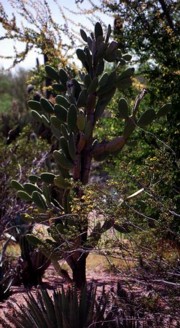

Genus:
Opuntia
Species: chlorotica

The prickly pear cactus is a widely used and versatile cactus. It can be used in many different ways such as foods, crops, etc.. In many places the prickly pear is grown as a crop, but in others they are just grown in the wild. The prickly pear has started to grow as a weed in some areas but in others it is vulnerable.
The prickly pear cactus grows in many places. It's found in the Sonoran and the Mojave Desert. The Sonoran Desert is located 25.3° to 33° North and 105° to 118° West.
In the Sonoran Desert it's very hot and dry, and the ground is very sandy. The temperatures drop very low at night and rise very high during the day. In the Sonoran Desert, rainfall, rather than time of the year, more clearly predicts the seasons than the calendar. It does have two rainy seasons. The Sonoran Desert is the wettest desert in North America with temperatures that vary in different months. In January the average temperature is 51.8° F, in April it's 65° F, in October it's 70.6° F, and in July it's 85.9° F. This cactus likes to grow in dry hot areas, as well as areas with intense monsoons and high temperatures.
The pancake prickly pear cactus grows up to 7 feet tall. It has circular pads arising from a thick, round trunk. The pads are actually fast growing stems. This cactus grows in a upright position with pads sticking out at all angles covered with barbed spin. The pads are four to six inches long, 9 inches wide, and .75 inches thick. The pads are very course and covered with spines. There are flowers located on the pads of the cactus. They are yellow with red centers and three to four inches wide. Several flowers grow on the edges of each pad. The fruit that grows from the flower are red or purple and turn gray when they get old. The fruit is one and six tenths to two and four tenths in diameter. The seeds of the plant are tan or cream colored and smooth with four-millimeter diameter.
There are many adaptations that the pancake prickly pear cactus has to the Sonoran Desert. Cacti have reduced their leaves to spines to reduce water loss and to protect the cactus. The roots of the prickly pear cactus are also made for very dry environment to help adapt to the deserts hot weather. Plants in the desert don\'d5t require much water or they need a way to store it for a drought. For example, the pads of the prickly pear cactus are used to store water for when they need it during a drought. In some places these adaptive significances help well. In some places these adaptive significances help well.
The pancake prickly pear cactus thrives as both a wild and domesticated plant.
by Prudence F. 2003
bibliography:
"Absorption."
http://www.esb.utexas.edu/sputtbug/Matt/absorption.htm
(1/1/03)
"Desert Cacti and
succulents for Southwestern Gardens."
http://ag.arizona.edu/gardening/cacti.html
(1/5/03).
"Desert
Seasons."
http://www.scenicdrive.org/pp0202seasons.htm
(1/1/03).
"Geography, Climate,
Life Zones."
http://www.scenicdrive.org/Geography.htm
(1/5/03).
"Prickly Pear
cactus."
http://encarta.msn.com/encnet/refpages/RefMedia.aspx?refid=
461522595
(1/6/03).
"Prickly Pear
Cactus."
http://www.rain.org/greennet/docs/exoticveggies/html/
pricklypear.htm
(1/1/03)
"Internal Movement
and Storage."
http://www.esb.utexas.edu/sputtbug/Matt/rectifier.htm
(1/1/03)
"Pancake Prickly
Pear."
http://www.whitethornhouse.com/cacti/cacti02-07.html
(1/1/03).
"Prickly Pear
Cactus."
http://www.desertusa.cam/magoct97/oct_pa/du_prkpear.html
(1/6/03).
"Prickly Pear
Cactus."
http://www.sfc.ucdavis.edu/pubs/brochures/pricklypear.html
(1/1/03).
"Research /Project
Results: Lower Sonoran Desert Biome."
http//www2.kpr.edu.on.ca/cdciw/biomes/sonorandesert.htm
"Root System of
Cacti."
http://www.esb.utexas.edu/sputtbug/Matt/system.htm
(1/1/03)
Rundel, Philip W. "Prickly Pear." World Book Millennium. 2000 ed.
"Sonoran
Desert."
http://helios.bto.ed.ac.uk/bto/desbiome/sonoran.htm
(1/1/03).
"Tonto National
Forest, Arizona Hiking the Transition Zone."
http://www.amwest-travel.com/awt_tonto.html
(1/1/03).